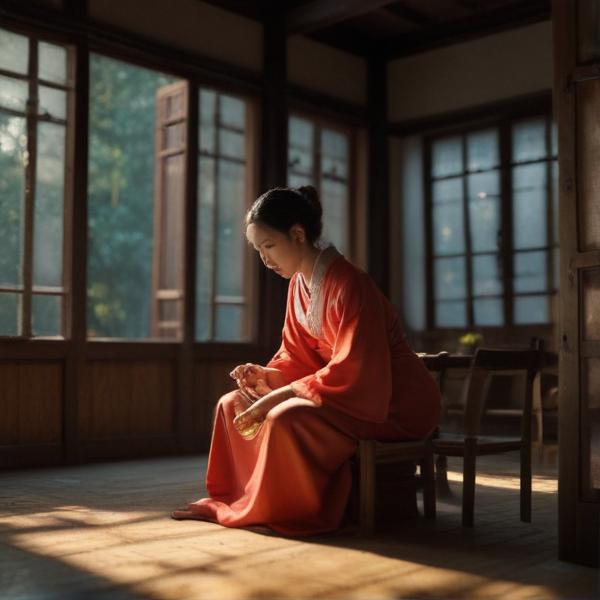基本信息 (Basic Information)
含义与用法 (Meanings & Usage)
中文核心释义 (Core Chinese Meaning): 白天,白昼,日间。
英文核心释义 (Core English Meaning): daytime, daylight, during the day
象形意义 / 为何这么写 (Pictographic Meaning / Writing Rationale)
文言文释义 (Classical Chinese Meaning)
与现代意义相近,指白天,与夜相对。Similar to modern meaning, referring to daytime, as opposed to night.
深入学习 (In-depth Study)
字源故事 (Origin Story)
字形演变 (Character Evolution)
常用词语和例句 (Common Words & Examples)
昼夜 (day and night)
他昼夜不停地工作。
Eng: He works day and night without stopping.
白昼 (broad daylight)
小镇在白昼中格外安静。
Eng: The small town is especially quiet in broad daylight.
相关成语 (Related Idioms)
昼思夜想
Meaning: to think about something day and night; to be preoccupied with something all the time
多语言翻译 (核心释义) (Translations (Core Meaning))
- French: jour, en journée
- German: am Tag, Tageszeit
- Spanish: día, durante el día
- Italian: giorno, durante il giorno
- Portuguese: dia, durante o dia
- Russian: днем, дневное время
- Arabic: نهار، أثناء النهار
- Persian: روز، در طول روز
- Dutch: overdag, dagtijd
- Polish: za dnia, dzień
- Vietnamese: ban ngày, trong ngày
- Ukrainian: вдень, денний час
视频学习资源 (Video Learning Resources)
通过以下链接在热门视频网站搜索 "昼" 的更多讲解:
Search for more explanations of "昼" on popular video sites:
- 在 Bilibili.com 搜索 "昼 字源 说文解字" (Search on Bilibili)
- 在 YouTube.com 搜索 "昼 character origin etymology" (Search on YouTube)
网络参考 (Web References for "昼") ()
网络内容摘要 (Web Content Summary):
-
核心含义:“昼”是“白天、日出到日落之间的时间”的意思,是2500个常用汉字之一。它的繁体字为“晝”。 Core meaning: "昼" means "daytime, the period from sunrise to sunset." It is one of the 2500 common Chinese characters, and its traditional form is "晝".
-
字形与起源:“昼”字在甲骨文、金文、小篆中均有记载。早期字形多以“日”(太阳)为主体,表达白天有日之意。 Character origin: The character has been found in oracle bone script and bronze inscriptions, often featuring the "日" (sun), emphasizing its connection with daylight.
-
常见用法与词语:“昼”常用于“昼夜”(day and night)、“白昼”(daylight)、“昼伏夜出”(inactive by day, active at night)等词语,以及成语“不分昼夜”(regardless of day or night)、“不舍昼夜”(without stopping day or night)。 Common collocations: Frequently appears in words like “昼夜” (day and night), "白昼" (daylight), and idioms such as “不分昼夜” (regardless of day or night), “不舍昼夜” (non-stop day and night).
-
易混淆点:与“夜”相对,注意“昼”仅指日间,而非全天。 Confusion point: "昼" refers only to the daytime (not the whole 24 hours, which would be "昼夜" together with "夜" for night).
-
文化背景:古诗文中常用“昼”形容白天的景象,如“日昼风烟静,花明草树繁”。 Cultural note: "昼" is often used in classical poetry to depict daytime, e.g., "日昼风烟静..." (in tranquil daylight, flowers bloom and trees are lush).
注:暂无特别的异体或复杂的用法,相关词汇和成语较为直接明了。 Note: There are no particularly complicated variants or uses; related vocabulary and idioms are straightforward.
昼 字源 字形演变 甲骨文 金文 说文小篆 - 百答知识
本页面为您讲解汉字"昼"从古到今的字形演变过程,以及汉字"昼"甲骨文 、金文、说文小篆、六书通的各个时代不同的写法。 zhòu 昼 (繁體字: 晝 ) 2500个常用字之一。
【昼,晝】的甲骨文金文篆文字形演变含义 - 甲骨文研究网 甲骨文密码字典 在线甲骨文字典研究 - 甲骨文研究网 甲骨文密码字典 在线甲骨文字典 ...
日昼风烟静,花明草树繁。----- 唐 . 戴叔伦《桂阳北岭偶过野人所居》 ③名词:白天,日出到日落之间的时段。 昼光 昼盲 昼日 昼夜 昼伏夜出 昼夜不息 / 白昼 不分昼夜 不舍昼夜 昼夜之象也。-----《易 . 系辞》 横柯上蔽,在昼犹昏。
更多图片 (昼 More Images) ()
